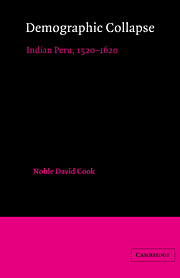Book contents
- Frontmatter
- Contents
- List of tables, figures, and maps
- Preface
- Introduction: The problem in perspective
- Part I Peru's preconquest population
- Part II Demographic collapse
- 8 First contact: north coast
- 9 Center of Spanish control: middle coast
- 10 Disease, earthquakes, and droughts: south coast
- 11 Intermediate area: northern highlands
- 12 Mining and population in the central sierra
- 13 The Indian heartland: southern highlands
- 14 An overview
- Abbreviations used in notes
- Notes
- Bibliography
- Index
- Titles in the series
14 - An overview
Published online by Cambridge University Press: 02 December 2009
- Frontmatter
- Contents
- List of tables, figures, and maps
- Preface
- Introduction: The problem in perspective
- Part I Peru's preconquest population
- Part II Demographic collapse
- 8 First contact: north coast
- 9 Center of Spanish control: middle coast
- 10 Disease, earthquakes, and droughts: south coast
- 11 Intermediate area: northern highlands
- 12 Mining and population in the central sierra
- 13 The Indian heartland: southern highlands
- 14 An overview
- Abbreviations used in notes
- Notes
- Bibliography
- Index
- Titles in the series
Summary
The magnitude of the decline varies with the figures given for 1530; but in any case, it does not fundamentally alter the shape of the curve: whether the population diminished by half or three-quarters, the effects of this fall on social structures were every bit as devastating.
Nathan Wachtel, Vision of the Vanquished, p. 87The demographic transformation of Peru was almost complete by the end of the first century after the Spanish arrived at coastal Tumbez. “Collapse” most aptly describes the process along the Pacific desert strip. With few exceptions, a once dense native population was wiped out and partially replaced by Europeans, Africans, and migrants from other regions. Remaining Indians were quickly integrated into the lower strata of colonial society. Collapse also occurred in the low-lying areas of the northern highlands. In the north and northeast, fewer outsiders immigrated to establish permanent settlements. That area therefore remained economically and socially outside the mainstream of the historical development of Peru during the colonial perod. The highlands proper, from Cajamarca, Conchucos, and Huailas southward to Lake Titicaca, also entered into the downward spiral, but in a less pronounced fashion. The highland population was more evenly spread over vast distances in contrast with the coastal populations, which were concentrated in narrow valleys. Population decline of the central and southern sierra was considerable; but not catastrophic as elsewhere. Large populations allowed the highland Indian to maintain social and economic institutions long after they were lost on the coast and in the far north.
- Type
- Chapter
- Information
- Demographic CollapseIndian Peru, 1520–1620, pp. 247 - 255Publisher: Cambridge University PressPrint publication year: 1982



